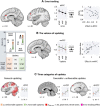Influence of vmPFC on dmPFC Predicts Valence-Guided Belief Formation
- PMID: 30104337
- PMCID: PMC6596151
- DOI: 10.1523/JNEUROSCI.0266-18.2018
Influence of vmPFC on dmPFC Predicts Valence-Guided Belief Formation
Abstract
When updating beliefs about their future prospects, people tend to disregard bad news. By combining fMRI with computational and dynamic causal modeling, we identified neurocircuitry mechanisms underlying this optimism bias to test for valence-guided belief formation. In each trial of the fMRI task, participants (n = 24, 10 male) estimated the base rate (eBR) and their risks of experiencing negative future events, were confronted with the actual BR, and finally had the opportunity to update their initial self-related risk estimate. We demonstrated an optimism bias by revealing greater belief updates in response to good over bad news (i.e., learning that the actual BR is lower or higher than expected) while controlling for confounds (estimation error and personal relevance of the new information). Updating was favorable when the final belief about risks improved (or at least did not worsen) relative to the initial risk estimate. This valence of updating was encoded by the ventromedial prefrontal cortex (vmPFC) associated with the valuation of rewards. Within the updating circuit, the vmPFC filtered the incoming signal in a valence-dependent manner and influenced the dorsomedial prefrontal cortex (dmPFC). Both the valence-encoding activity in the vmPFC and its influence on the dmPFC predicted individual magnitudes of the optimism bias. Our results indicate that updating was biased by the motivation to maximize desirable beliefs, mediated by the influence of the valuation system on further cognitive processing. Therefore, although it provides the very basis for human reasoning, belief formation is essentially distorted to promote desired conclusions.SIGNIFICANCE STATEMENT The question of whether human reasoning is biased by desires and goals is crucial for everyday social, professional, and economic decisions. How much our belief formation is influenced by what we want to believe is, however, still debated. Our study confirms that belief updates are indeed optimistically biased. Critically, the bias depends on the recruitment of the brain valuation system and the influence of this system on neural regions involved in reasoning. These neurocircuit interactions support the notion that the motivation to maximize pleasant beliefs reinforces those cognitive processes that are most likely to yield the desired conclusion.
Keywords: DCM; belief update; computational modeling; optimism bias; value; vmPFC.
Copyright © 2018 the authors 0270-6474/18/387996-15$15.00/0.
Figures




References
-
- Bastin J, Deman P, David O, Gueguen M, Benis D, Minotti L, Hoffman D, Combrisson E, Kujala J, Perrone-Bertolotti M, Kahane P, Lachaux JP, Jerbi K (2017) Direct recordings from human anterior insula reveal its leading role within the error-monitoring network. Cereb Cortex 27:1545–1557. 10.1093/cercor/bhv352 - DOI - PubMed
MeSH terms
LinkOut - more resources
Full Text Sources
Other Literature Sources
Research Materials
